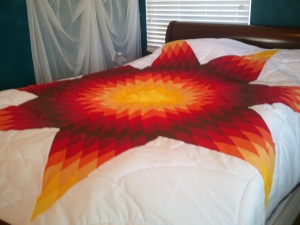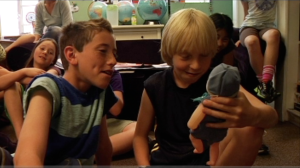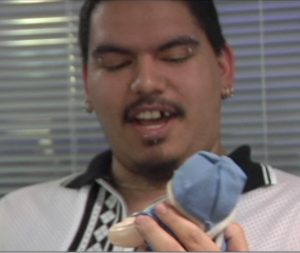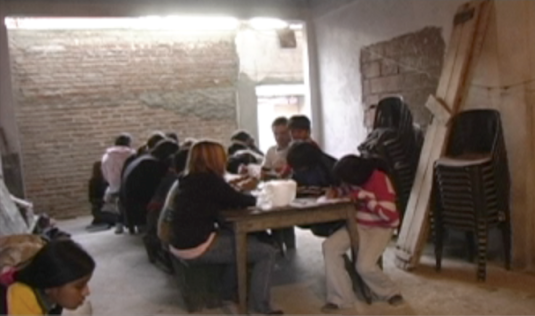And a quick capture of what we experienced on the 2010 tour…
South East Asia: Early this year, we Partnered with Loesje Jacob and practitioners of a form of energy medicine called Body Talk, and I joined them in a trip to Indonesia and Malaysia. In Indonesia, we worked with a team of youth and 8 different orphanages. We learned about Body Talk together, and taught the orphans the Body Talk techniques. Those volunteers who participated in the journey experienced profound and transformative healing, perhaps even more then the orphans! While we were there, a film crew shot a documentary about the Body Talk journey, and I was delighted at an invitation to share my transformative work with the Global Peace Train toys. I presented exercises to the youth on film, exploring healing and transformation with the stuffed animals they brought on the trip. We were honored by the opportunity to work with these youth in groups; it was a real and tangible test of the Global Peace Train method in a group setting. The outcome was a deep appreciation for the healing power of play and the narrative transformations that come from collective imagination. Click here to learn more.

Children in Indonesia
After Indonesia we traveled into the jungle of Malaysia and met with the Orang Asli (Tribal Peoples) of that region. We participated in their sacred ceremony, learned about how the ancient traditions merge with current culture, and explored technology that created sustainable living.
By day we explored the small village. Here, people grew their own food, used solar panels for electricity and shared hard work while enjoying the simple life. We were embedded deep in a valley, the village was composed of houses on stilts, with home gardens everywhere and chickens and children running around playfully. We lived in a separate bamboo village built especially for us with nine huts, equipped with bare amenities.
By night we were lead by guides carrying tall bamboo torches into a long hut where the sacred ceremonies took place. We had freshly woven crowns and medicine bundles that were made that day with sacred herbs cut from the jungle. We danced in the pitch black to the echoes of crude bamboo instruments banging an unworldly song. There were harmonies sung in a different language, it was magical. I felt like I was being connected to something I had long forgotten. Although I was in the middle of nowhere, I felt more connected to our universal humanity then I ever had.
The confluence of the very ancient and modern was striking. We learned how one people take ancient traditions and merge them with modern technology for the happiness of the people. Also striking was the lack of centralized monetary systems; they don’t depend on these as we do everywhere else. This wraps up our journey with Body Talk International.
Salt Lake City, Utah:Shortly after the trip to South East Asia we lead a project with the homeless in Salt Lake City. This was a real test of our Global Peace Train journeys; we were six volunteers embodying our vision of alleviating poverty through play with the homeless community. We dressed in costume representing any character we chose: the average American, the media, corporate America, a crazy man, and someone’s child. We then explored with video, traditional photography, and imaginative play, what insight we could discover within the rolls. What we discovered was that homelessness affects everyone. Within the media people everywhere were facing foreclosures. It was not just the obvious homeless person on the street.

John (right) Hollywood (left)
We then took a journey with the homeless population in order to explore the essence of homelessness. The homeless men that we were working with taught us how to fly signs, how to panhandle, what wording to use, where the best places were to beg for money, and the skills required to be homeless. They shared intimate stories and gave us a sense of being thoroughly conquered and giving up on life. While the homeless were left despondent, our volunteer’s eyes were opened. Monica Eliee Henrie, one of our volunteers, mentions: “Spending the day with the homeless opened up a whole new perspective on life for me…I was able to step out of my comfort zone and…was really taught to love unconditionally…We’re all in this together.”

Monica Henrie
According to the testimonials and feedback, we found that the point is to awaken a passion and consciousness in the volunteers to open their eyes and take action. As a result Global Peace Train began to explore how to create a vehicle, a train, which could actually change the world and use the natural talents and passions of anyone to make it happen. When people ask how they can help, instead of handing off the boring office work, we ask the questions: “What do you love to do the most? Where would you like to adventure and who would you like to meet that is suffering? How can the Global Peace Train help you take that journey?”
Fundraising: When spring came my investments ran out and the fundraising efforts began. Since, we have raised close to $3000 for the Miracles with Microloan’s Project in Kenya and $25,000 for the Star Quilt project on the Pine Ridge Indian Reservation.
Programs: The microfinance program in Kenya delivers small loans and education to women in the slums so they can start small businesses. We have hired on Karen Sugar who runs the Women’s Global Empowerment Fund www.wgefund.org, started designing the systems for the program, and put in all the paperwork for a local NGO in Kenya we are calling PACHO which means “Home”. We are aiming to raise the next $15,000 in order to finish the preliminary organizational work, training, and actually distribute the loans by this spring. This project still strongly needs funding to help lift women from Kenya out of poverty and our goal is to make it manifest in 2011.

The mission of the Lakota project is to empower the native women to build an economy and share their tradition. By designing an e-commerce website and teaching them skills in business, they learn how to bring their beautiful quilts to market with integrity, play, and passion. We are proud to announce that we have received our first shipment of these sacred quilts, driven personally by the native artist Germaine Moves Camp, from South Dakota.

Germaine Moves Camp
Also a moving force on this project is a Medicine Man named Sam Moves Camp. His grandfather worked alongside the famous warrior Crazy Horse in the late 1800′s. I am excited to take another trip to the Reservation soon to sit down with him and receive a greater teaching on the ancient meaning of the star quilts. It is our intention to create a sacred experience for those who purchase these quilts. Participating in this commerce is a way to learn about the Native Lakota tradition and feel connected to the sacred human experience. Our mission is to create these same qualities in all of our projects.

In 2010 Global Peace Train also began to work with the Gang Members in Denver. We began using GBaby to explore the viewpoints of those within gangs, those who have fully transitioned out of gangs as well as kids, entrepreneurs, students and people of all ages. We used GBaby as a tool to uncover participant’s inner wisdom and build a collective story from their real lives and imaginations.

We have begun to create a bridge that allows both sides of the gang phenomenon to break apart stereotypes and open up lines of communication. In 2011 we are looking forward to furthering the production of the GBaby Album and Music Video in order to further establish the brand and bring forth programming for the gang members who are ready to get off the streets. We intend to do this by opening up job opportunities for the youth that align with their passions and talents.
 Juan
Juan
We also explored the practicality of these tools when we partnered with the World View Project at Naropa University, and The Prodigal Son to uncover the world views of transitioned gang members. Our preliminary findings indicate that opportunities for action and taking new roles in life are vital for the transition out of gangs.

India
Angel Capital Summit: To top off the years achievements we were hand selected as one of three non profits to present at the Angel Capital Summit in Denver. I worked with a team of more than 10 different consultants to get the investor presentation right, and the presentation ran smoothly. Of especial help was LaRiesse Dimmick, the Chief Business Strategist for Trendant Consulting http://www.trendant.comwho flew in for the summit from Salt Lake City, Utah.
Having a Chief Business Strategist to put all the actual systems together and make the machine run as a whole is very important for a creative Executive Director like me. In order to achieve our long term goals, we anticipate a long consulting relationship with LaRiesse and Trendant Consulting and are so excited to have them onboard the Global Peace Train.
This has been an inspiring, challenging, and growth-promoting year for Global Peace Train. Thank you all who have donated your heart, soul, time, and money to our projects! We are still growing, and need donations more than ever to continue the growth and development of all our activities. The transformation that happens occurs through the kindnesses of our donors and volunteers, so please continue to donate if you already do so, and begin donating time or money if you have not.
In closing, I would like to extend another warm invitation to you to explore your own passions and see what seat might be available on the Global Peace Train for you. Whether it be a board position, volunteer, paid or short visit we look forward to taking the journey with you! In addition we currently have a Global Peace Train Journey that we are looking to continue… if you happen to be traveling to Costa Rica anytime soon and would be interested in an adventure please let me know.
Warm Regards,
Aja Duniven
Engineer of Serendipity
aja@globalpeacetrain.com
 From the outside it may look like I have things together, but most of the time I really have no idea what is going on. Just like everyone else I am in the middle of the wonderful unfolding called life. Some days I feel cheerful and optimistic, other days I am overwhelmed by the day to day things that must be attended to and unexpected events like death of a loved one. In fact, I’m sending out a big rainbow of love this week for my dear Sofie who crossed over to whatever is on the other side of death and I’m taking plenty of time to feel sad too. I could not see this death coming and yet I am here in the middle of the experience. The news has created a great opportunity as well, the opportunity to connect deeply with others who are also feeling impacted by Sofie’s abrupt death.
From the outside it may look like I have things together, but most of the time I really have no idea what is going on. Just like everyone else I am in the middle of the wonderful unfolding called life. Some days I feel cheerful and optimistic, other days I am overwhelmed by the day to day things that must be attended to and unexpected events like death of a loved one. In fact, I’m sending out a big rainbow of love this week for my dear Sofie who crossed over to whatever is on the other side of death and I’m taking plenty of time to feel sad too. I could not see this death coming and yet I am here in the middle of the experience. The news has created a great opportunity as well, the opportunity to connect deeply with others who are also feeling impacted by Sofie’s abrupt death.











